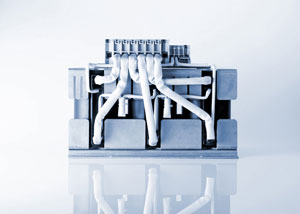
The strong magnetic fields of an MRI scanner or a particle accelerator are generated efficiently by electromagnets that have superconducting wire in their coils. A group of scientists has discovered how to make better wires using a promising material known as Bi-2212. With this discovery comes the possibility of creating magnetic fields in excess of 30 Tesla, three to four times higher than those generated by present accelerator magnet technology.
Bi-2212 (Bi2Sr2CaCu2Ox) is one of the copper-oxide high-temperature superconductors discovered 27 years ago. Since then, attention has focused on the use of such HTS materials in electric power transmission and other electrical applications not related to high-field magnets. In those applications, Bi-2212 loses out to other HTS materials.
Yet scientists had recognized for a long time the potential of Bi-2212 for use in superconducting magnet coils. When cooled with liquid helium, many HTS materials, including Bi-2212, can conduct large electric currents without resistance even in the presence of huge magnetic fields. But so far scientists only have managed to turn three of these HTS materials into the long wires that are necessary to make coils. Among these materials, Bi-2212 stands out as the only HTS that can be fabricated as a round wire. This makes Bi-2212 a perfect candidate for winding cables and coils without significantly changing present magnet technology.
Until recently, Bi-2212 wires more than a few centimeters long wouldn’t carry enough electric current to make it worthwhile to consider them for magnet technology. Recently, a group of scientists, including Tengming Shen at DOE’s Fermi National Accelerator Laboratory, announced how to beef up the electrical capacity of Bi-2212 wires. Previous studies by Shen and collaborating scientists had shown that the wire’s low current density is due to gas bubbles that form during a process that melts and re-solidifies thread-like filaments of Bi-2212.
Shen and Arup Ghosh, a scientist at DOE’s Brookhaven Lab, now have discovered (arXiv paper) that the root cause of the problem is that the high gas pressure inside the long-length Bi-2212 wires deforms its soft silver cladding irreversibly. They observed that long-length conductors swell, crack or even bulge locally at high-temperatures due to contaminants such as air and water, which get absorbed by Bi-2212 powder, and solid remnants in powder that gasify upon heating. This explained why short pieces of Bi-2212 performed well, but long wires did not.
This problem can be solved by applying a technique developed by a group of scientists led by Professors David Larbalestier and Eric Hellstrom at the National High Magnetic Field Laboratory (NHMFL). The new process prevents bubble formation almost entirely by performing the melting and re-solidification of materials under high external gas pressure. The NHMFL group observed five times higher current in a long wire sample made by the new method compared to an identical sample made by the standard recipe.
Importantly, the electrical currents in the improved Bi-2212 wires were two times larger than the usual benchmarks used for the development of superconducting magnet coils.
These breakthroughs signify the birth of a new high-performance, very-high-field magnet conductor. Shen and his collaborators are optimistic that they now have the recipe for a new class of superconducting magnets that could help unlock information about chemical and biological processes, create new materials and reveal the fundamental processes of the universe.



